Samsung Galaxy S 4 Review - Part 1
by Brian Klug on April 24, 2013 12:01 AM ESTDisplay
We wrote about how we suspected that SGS4 would go to a 5-inch 1080p SAMOLED display just after CES. Turns out that was spot on, as the SGS4 includes a 5-inch 1080p Full HD SAMOLED panel, the latest in Samsung's AMOLED roadmap. Samsung's naming stays true, and there's no Plus tacked on at the end, so we get another non-RGB stripe subpixel geometry with SGS4. The last few Samsung AMOLED variants we've seen have had different subpixel grids, and the one on the SGS4 is possibly the most interesting to date. There's still a bias toward more green subpixels than blue or red, this isn't an RGB stripe at all, but instead of the previous RG,BG layout we see this offset pattern with green on one line, then blue and red on another line. Interestingly enough the blue subpixel appears to be a square, and red and green appear to be circles, with the difference in area possibly offsetting the luminous efficiency of each material. Whatever the reason (Samsung has never been official or forthcoming any of these subpixel patterns each time they've changed them) it's present on the SGS4.
At this size however I have to admit that I find the pursuit of the subpixel geometry more of an educational one than something which affects users. While I could occasionally see it on the SGS3, I definitely do not see it on SGS4. The subpixels are now small enough that whatever the pattern, it all looks like a homogenous light-emitting surface, which was the goal after all. I could bring up the visual acuity discussion again but just trust me that it's small enough to not be visible even with actually perfect (not legally perfect, which is different) vision.
So resolution is great and up to par with all the other LCD-bearing flagships this year, lack of RGB stripe notwithstanding. There's that remaining question about brightness, contrast, outdoor visibility, and of course calibration and the saturation issue that has persisted with AMOLED from generation to generation.
On the brightness front, the SGS4 includes dynamic contrast functions that cannot be disabled and change as a function of what is being displayed. There's an "auto adjust screen tone" checkbox under display but don't let that fool you, that doesn't disable dynamic contrast, just white point. Under screen mode are the mDNIe toggles we've seen on countless other previous Samsung Android phones with AMOLED panels, only here we notice something interesting. There have always been four toggles as long as this option has existed, only what's different is now, one of them is named "Professional photo." Reviews of other regional variants of the SGS4 have included the same button but marked "Adobe RGB." Oddly enough it seems that the North American versions at least have this renamed for some reason, but undoubtedly the function is the same. Many speculated that this is now a toggle for some full CMS (Color Management System) which "fixes" the inherent color space issues with AMOLED and oversaturation that occurs when looking at sRGB content on such devices. Unfortunately, I can confirm that my initial suspicions that this is just a continuation of the mDNIe (lite) settings from previous generation is in fact correct. I reverse engineered what I could of these settings from both kernel messages while changing the toggles, and looking at the kernel sources. Turns out that 'Professional photo' mode is actually the 'Natural' mode renamed from previous versions.
So the question was whether the color space or white point actually does change with this mode enabled. I ran the SGS4 through our display tests in each of the modes and think the full color space plot tells the story. The sanest of them all really ends up being the strangely-named 'Movie' mode. Professional photo gives the big gamut with a white point closer to 'Movie,' which is to say around 7000K, but it doesn't fundamentally change the still-present oversaturation or color management issue that exists in Android with these wide gamut displays. Most users admittedly don't care however and just see "bright" colors. Theres' an Auto mode as well which the device ships with that basically has a matrix of mDNIe settings for targeted applications (for example the Gallery, Browser, Video playback) and so forth get settings, which you can see in the kernel.
| CalMAN Display Comparison | ||||||||||||
| Metric | iPhone 5 | iPhone 4S | HTC One X | SGS3 | Samsung Galaxy Note 2 | Google Nexus 4 | HTC Droid DNA | HTC One | SGS4 | |||
| Grayscale 200nits Avg dE2000 | 3.564 | 6.162 | 6.609 | 4.578 | 5.867 | 7.686 | 6.738 | 5.391 | 7.511 | |||
| CCT Avg (K) | 6925 | 7171 | 5944 | 6809 | 7109 | 8506 | 8108 | 8118 | 7020 | |||
| Saturation Sweep Avg dE2000 | 3.591 | 8.787 | 5.066 | 5.460 | 7.986 | 8.517 | 5.856 | 3.365 | 7.823 | |||
| GMB ColorChecker Avg dE2000 | 4.747 | 6.328 | 6.963 | 7.322 | 8.185 | 7.531 | 6.687 | 4.656 | 7.440 | |||
In the "Movie" mode things are better controlled than the Note 2 on the GMB color checker card test, which is the most important one for me. White point is also no longer the crazy 8000K that we saw before, 7000K is commendable for Samsung at this point. Keep in mind that maximum brightness changes in each mode as well as we effectively clamp things, I measured a maximum of 319 nits in Dynamic mode, 311 nits in Movie mode, and 255 nits in Standard, for example.
Running the display at maximum brightness for too long will also get you into an overheating or thermal protection mode as well, which we've seen on countless other AMOLED variants. Most of the time I suspect users will run on Auto brightness however which keeps brightness down to a much lower level to save battery and prevent that from becoming a problem.
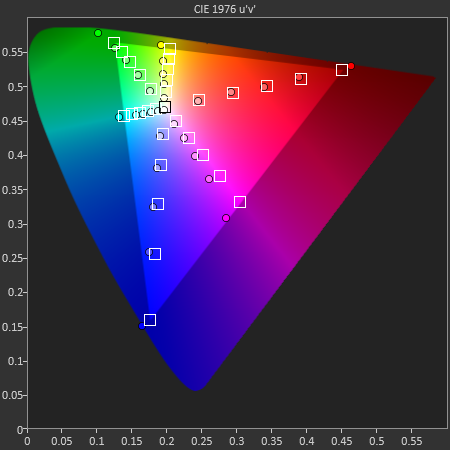
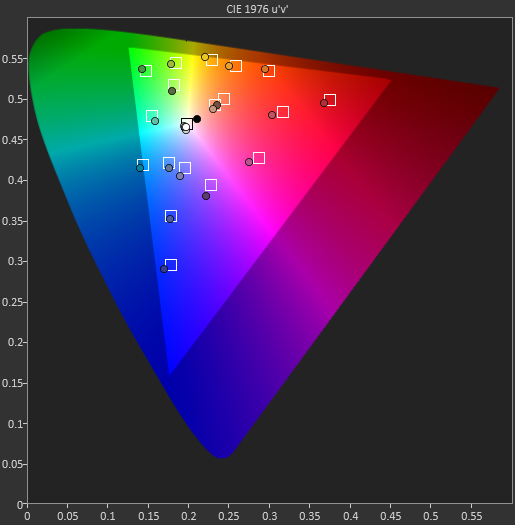
Because "Movie" was the closest to sRGB of all the modes, I selected it for the actual results that I'll present in the table. Admittedly this mode does tighten things up a bit, but it still isn't perfect and I'd still like to see Samsung do something to reign this in at some point.


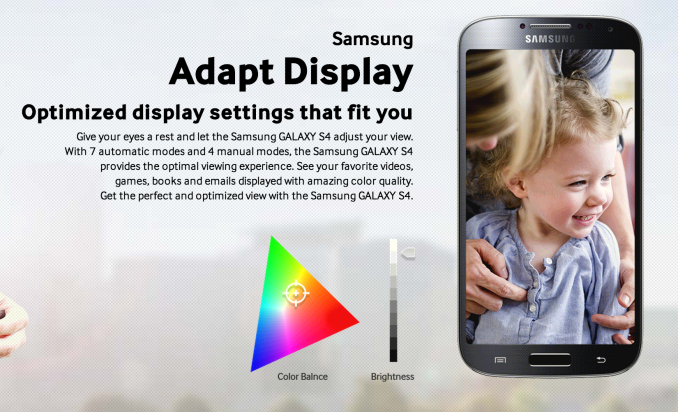




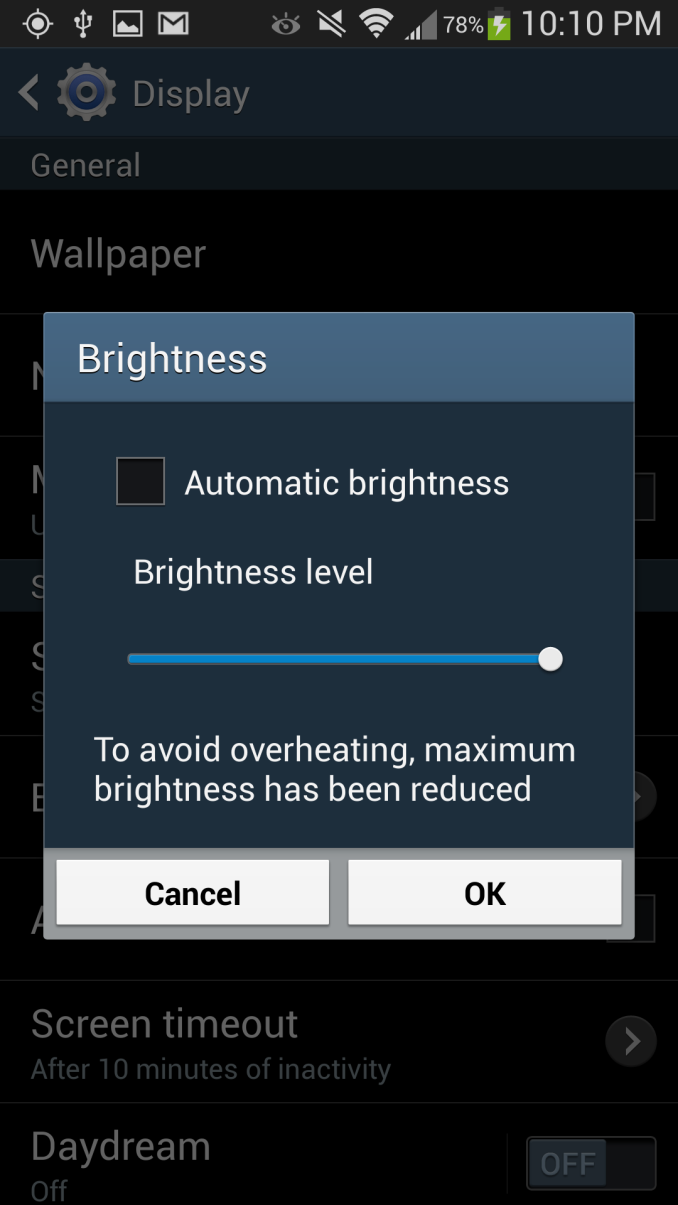
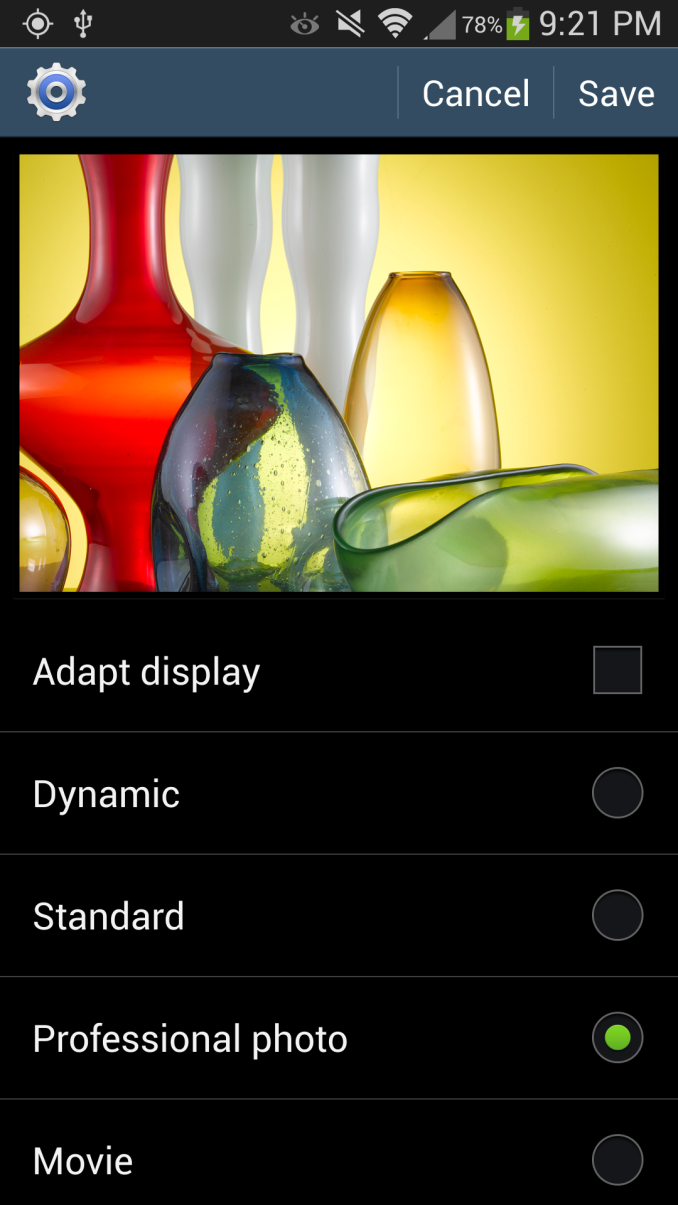
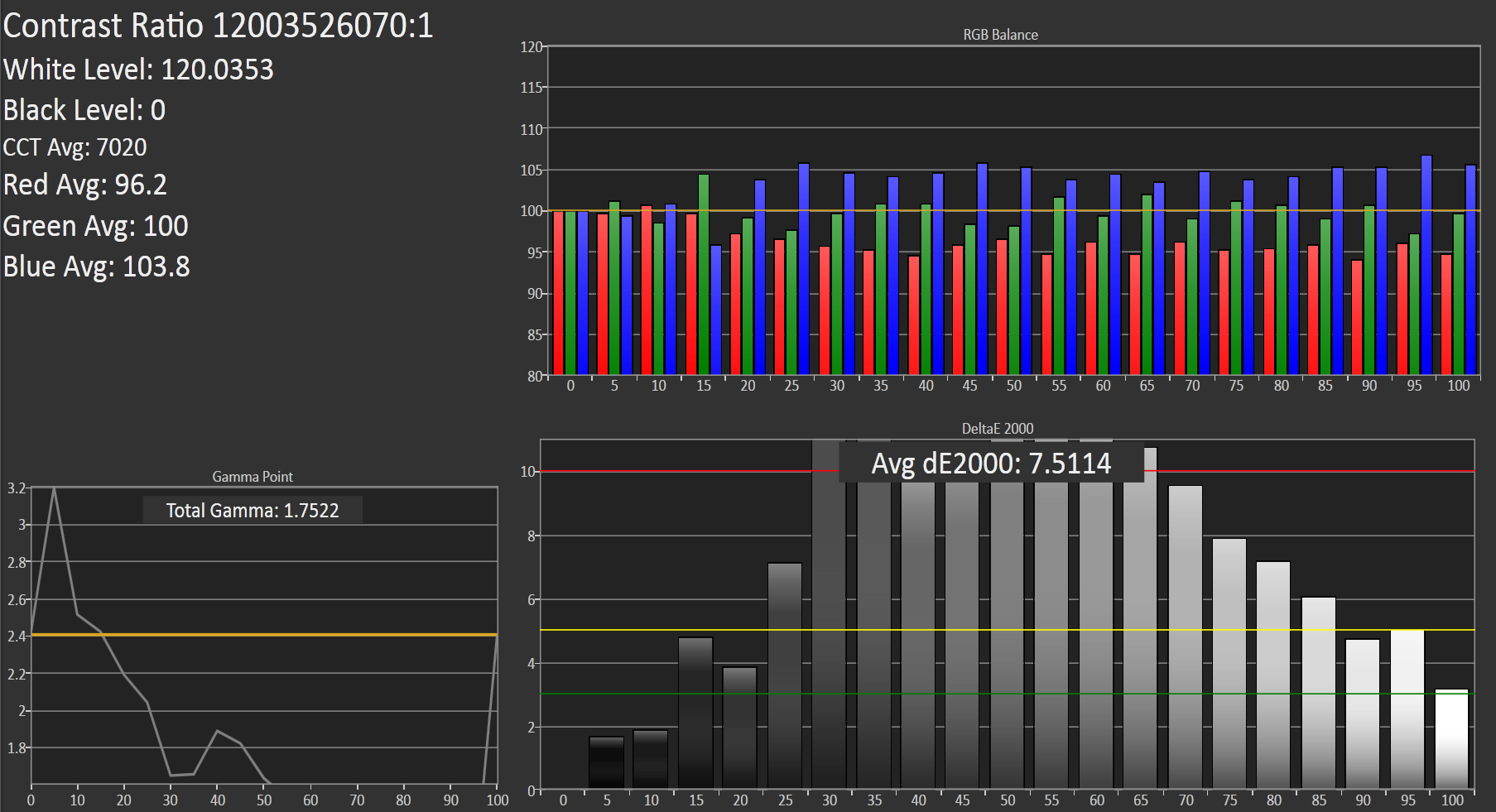








335 Comments
View All Comments
mayankleoboy1 - Wednesday, April 24, 2013 - link
1. Out of the box, how does SGS4 display compare to HTC one ?2.This review feels a bit cramped, mainly because Samsung/QC hasnt given much info on the SoC. (To be clear, the reviewer cant do much here).
netmann - Wednesday, April 24, 2013 - link
Apple iPhone 5, Google Nexus 4, HTC One, Samsung Galaxy S4....they all being reviewed at AnandTech while Nokia Lumia 920 keep getting ignored!?aelwyn - Wednesday, April 24, 2013 - link
Because, with the exception of the iPhone, they're comparing Android phones. People interested in the S4 are probably not even considering a Windows phone. The iPhone is included simply because, right or wrong, it's the benchmark against which other smartphones are measured.kyuu - Wednesday, April 24, 2013 - link
He was talking about the phones actually getting reviewed, not their inclusion or exclusion from the charts in this article.Quite a while ago a Lumia 920 review was supposed to have been in the works, but it never materialized and I have never seen an explanation for why it was (apparently) canned. Maybe we'll get a review of the 928, which, despite a few change-ups, is largely identical.
maximumGPU - Thursday, April 25, 2013 - link
indeed, we were promised a 920/HTC 8X review and never got one. I think it's a bit unfair towards the windows phone community.jeffkibuule - Thursday, April 25, 2013 - link
Windows Phone 8X: http://www.anandtech.com/show/6692/from-mango-to-a...I think what you really want is an in depth review of the 920, but from a hardware standpoint, there's little remarkably new about either when it was released or now. Perhaps it would have been more honest to have a review of Windows Phone 8 in general, but there's not much new to show for it.
val580 - Wednesday, April 24, 2013 - link
18 unread sms and 23 missed calls :-) wish I had that number of girlfriends lolbmgoodman - Wednesday, April 24, 2013 - link
Many of you will regret buying this phone with Android 5 rolling out in the coming weeks! Trust me, as a Galaxy S2 owner, I know only too well how many upgrades that Samsung/AT&T combined to totally bork my phone! The worst was the "Sleep of Death" that was added in 4.0.4 and took nearly 4 months to correct. Then there were other "features", like not reconnecting to the wifi after waking the phone, potentially using LOTS of extra data from your cellular data plan. Samsung has also stopped providing technical information to the developer community and many of the custom ROM developers are giving up. There is *still* not a stable version of CyanogenMod based on Android 4.1 for the Galaxy S2, for example.Sure, there's a lot I love about my phone, but I'm reluctant to buy another Samsung. That said, if you're happy with 4.2.2, and you can manage to keep Samsung from "upgrading" you, you may well be pleased with the phone for a few years. (I won't even get into hardware reliability, other than to say that my phone is now exhibiting some strange minor Bluetooth issues.)
Gray05 - Wednesday, April 24, 2013 - link
If you don't run custom ROMs, you are likely going to wait a long time to get updates. And just like the version the phone ships with, the updates suck. That is reality. From what I see, that is independent of what carrier/OEM you use.If you insist on using CyanogenMod as your ROM, ok. But there are plenty of stable ROMs out for the S2.
sigmatau - Thursday, April 25, 2013 - link
I am extremely leery about Samsung. I've owned a GS2 and hated it. It had a hesitation issue with the UI and I have noticed it in the GS3 too. I find it annoying having to wait for it to flip my screen when I want to type an email. It seemed like a second too late and I found myself shaking the phone to try to activate it. The lock screen was beyond stupid where you couldn't set a time before it would ask for your PIN. There were the options in the settings, but they didn't work.And don't start me on the fail built in email. I use my phone for work and find myself typing many emails on it. My GS2 would crash so much during email typing that I had to throw it one day. So much lost time on that POS. Samsung also took about a year to upgrade it to ICS even though it came out a month after the US's release.
Then there were random times that my SD card would be wiped randomly and all my music with it. It's fairly annoying having to reload almost 20 GBs of music on those slow memory sticks.